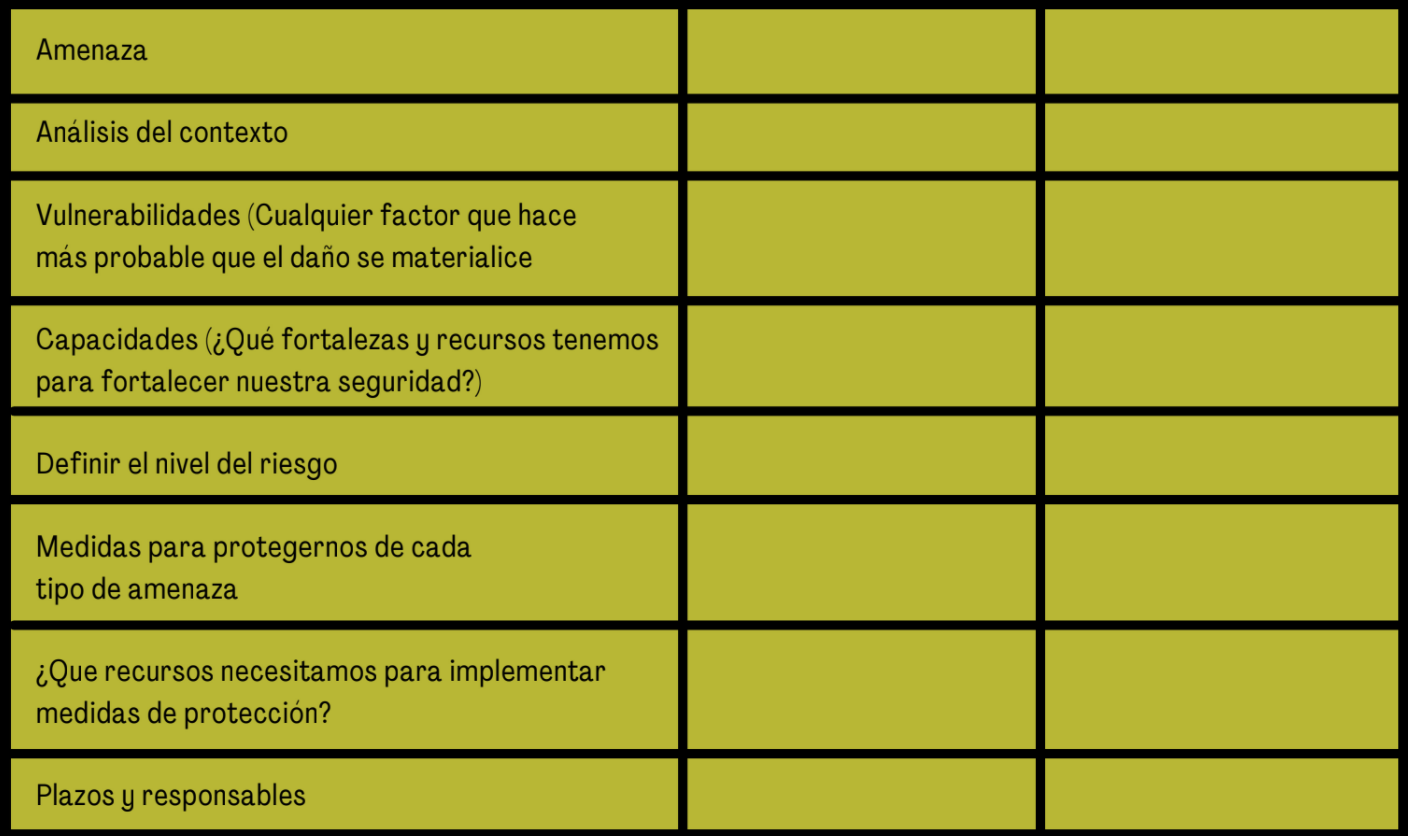Safety and protection for Environmental Defenders
Goals
- Reflect on the importance of starting to work on the issue of security and protection in our organizations, communities and territories.
- Briefly share key concepts: comprehensive safety and protection, threat, risk, vulnerability, security plan.
- Share good practices of care and self-care.
Introduction
Why is it important to talk about security and protection for Environmental Defenders? Why do women face different risks than our male colleagues?
We invite you to watch the following videos:
Women defenders, climate change and extractivism
We live in a world organized by the capitalist system, which is essentially extractivist. It needs the violent exploitation of all natural resources such as water, land, and minerals (among others) for its existence. This system threatens life, and especially affects the territories where peasant, indigenous, Afro-descendant and marginal urban communities are settled. Promoted by national and local governments, extractivism generates a risky and unsafe context for the territories and their communities. At the same time, the territories are strongly affected by the alarming effects of climate change on natural resources (droughts, high temperatures, floods, among other multiple consequences) of high vulnerability for the communities.
Faced with this threatening and risky scenario, groups of Environmental Defenders exercise their human rights (such as freedom of expression, freedom of association, freedom to participate in decision-making) in order to protect the environment. Women defenders are organizing, training and generating different strategies to defend their territories and their own communities in the face of the current humanitarian crisis. Due to their actions and demands, they often receive threats, intimidation and abuse from private individuals, as well as institutional violence from authorities and public officials. Facts that endanger the physical integrity of the defenders as well as that of their organizations and communities. However, even though they are the most vulnerable, they are on the front line of defense, putting their bodies on the line to resist.
Latin America is among the most dangerous regions in the world for people who defend rights, but it is also considered the most dangerous region for women. This situation has a direct connection with the closing of spaces that is experienced in most countries and with the control of democracies by elites.
In 2020, Global Witness recorded the murder of 227 people defending the land and the environment. This makes the past year once again the most dangerous on record for people defending their homes, land and livelihoods, as well as ecosystems that are vital to biodiversity and climate. In some countries, the situation facing defenders is difficult to measure. Restrictions on press freedom as well as the absence of independent records of attacks against defenders can lead to underreporting.
We know that beyond killings, many defenders and communities are also silenced through tactics such as death threats, surveillance, sexual violence or criminalisation. And these types of attacks are even less reported.
More than 1 in 10 defenders killed in 2020 were women. While the number of recorded killings against women appears to be lower, those who act and speak out can also face gender-specific threats, including sexual violence. Women often face a double challenge: the public struggle to protect their land, water and our planet, and the often invisible struggle to defend their right to protest within their communities and families. In many parts of the world, women are still excluded from land ownership and discussions about the use of natural resources. In this context, the objective of this module was to train us in security and protection strategies and mechanisms to protect our physical integrity, that of our organizations and territories.
What are our experiences of attacks, threats, feelings of insecurity?
At Feminist School for Climate Action, we think about SECURITY and PROTECTION from a comprehensive, gender-based and intersectional perspective. We do not defend a prison-based or punitive idea of security, but rather a security that is based on the fulfillment of the human rights of peoples.
We understand the different dimensions that make up the security of women defenders: physical, emotional, organizational, territorial and digital.
Below, we share some testimonies from our workshop on 11/20/21:
“Racism is latent and necropolitics is killing us. We want to strengthen ourselves and strengthen our security”
“This week, a feminist colleague received an email in which she was threatened with rape, this because she is part of an anti-mining defense process. Women are always facing the culture of rape, in the case of defenders of the territory it is something very common. Political violence on social networks is increasingly present.”
HOW DO WE DO WHEN IT IS THE STATE ITSELF THAT THREATENS OUR SECURITY?
Bolivia:
“There are verbal threats in the demonstrations that we accompany as organizations. We pass by and they shout things at us.”
Brazil:
“Talking about security is a challenge for us. Because before this was guaranteed by law and it was already a challenge and today it has intensified. The public policies that are being implemented by the Bolsonaro government increase the political persecution of activists, social movements. We are accused of vandalism. We have several feminist colleagues and indigenous movements being persecuted and threatened, even being murdered. We see a great increase in deaths and political persecution of indigenous people and landless people.”
Ecuador:
“In Ecuador, trials and imprisonments against defenders of Human Rights, land and territory are multiplying. Mass killings in prisons are also multiplying. In the last one, a defender of nature arrested the previous year and a trans woman were killed. I think we should reflect on whether feminisms should also be anti-prison.”
Methodology and steps for the construction of security plans
How can we improve our security?
We can do so with strategies/plans and action protocols against possible risks and threats. To do so, it is essential to:
- Have a good analysis of the context and mapping of actors.
- Identify threats and risks, analyze our vulnerabilities and capabilities.
- Always keep a record of the facts we see.
- Agree on specific actions to take care of future events that may arise.
THREATS
THREATS are the possibility that someone may harm our physical or moral integrity, that of another person or their property through an INTENTIONAL and generally violent ACTION. It is a declaration or manifestation of intention to cause damage or harm. There are declared/direct threats (when they threaten us directly) or probable/indirect threats (when they threaten a nearby defender and we believe that we may be the next one threatened).
RISK
RISK would be a possible event that occurs. And if it occurs, it will cause us damage and harm. The level of risk increases based on the number of threats we receive. And at the same time, our vulnerability increases.
This risk decreases if we increase our capabilities to manage threats, for example, by implementing our security plan, improving our communication and increasing the number of allied organizations.
Documents from the session





